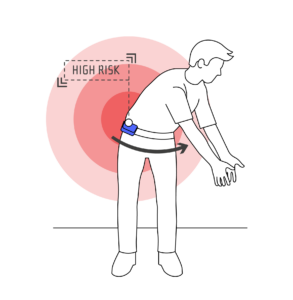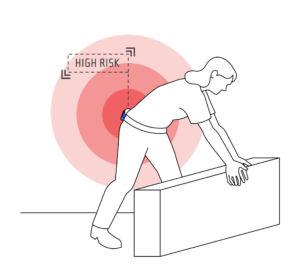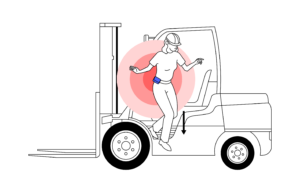Sprain and strain injuries in the workplace can occur in any industry but are more common in jobs that involve manual labor, repetitive motions, or awkward postures, such as those of frontline workers.
Consider the warehouse worker who repeatedly reaches overhead to select items; the nurse who repositions patients in awkward positions; or the delivery driver who bends again and again to load and unload products. When these workers move their bodies improperly, day after day, their risk of a strain or sprain injury increases.
What are Strain & Sprain Injuries?
Strain and sprain injuries affect the muscles, tendons, ligaments, and other soft tissues of the body. These common workplace injuries can be caused by a variety of factors, including high-risk postures.
High-risk postures are positions that put excessive strain on the muscles, tendons, and ligaments of the body. These postures can be caused by elements such as the design of the workplace, the equipment used, and the tasks performed.
Examples of High-Risk Postures
According to the 2023 Travelers Injury Impact Report, the most common cause of accidents across all industries was overexertion, including strains or injuries resulting from twisting, reaching, lifting, or jumping.
Let’s take a closer look at these common high-risk postures:
Twisting: When twisting the body to perform a task, it’s important to use proper techniques to avoid injury. Twisting the spine vs turning, or twisting too far or too quickly, can put excessive strain on the muscles and cause a strain or sprain injury.

Reaching: When reaching for objects that are above shoulder height, it’s important to use proper techniques to avoid injury. Stretching too far can put excessive strain on the muscles and cause a strain or sprain injury.

Lifting: When lifting heavy objects, it’s important to use proper lifting techniques to avoid injury. Lifting with the back instead of the legs, for example, can put excessive strain on the muscles and cause a strain or sprain injury.

Jumping: When jumping, it’s important to use proper techniques to avoid injury. Landing improperly can put excessive strain on the muscles and cause a strain or sprain injury.

The Consequences of Strain & Sprain Injuries
Strain and sprain injuries can have serious consequences for both the employee and the employer. Here are some of the potential impacts:
On Employees:
- Pain and discomfort: Strain and sprain injuries can cause pain and discomfort that can make it difficult for employees to perform their job duties.
- Lost wages: If the injury is severe enough to require time off work, employees may lose wages while they recover.
- Reduced mobility: Injuries can reduce an employee’s range of motion, making it difficult to perform tasks that require movement.
- Chronic pain: In some cases, strain and sprain injuries can lead to chronic pain that can last for months or even years.
On Employers:
- Decreased productivity: When an employee is injured, they may not be able to perform their job duties at full capacity, which can lead to decreased productivity.
- Increased costs: Employers may incur additional costs related to workers’ compensation claims, medical treatment, and hiring replacement workers. Sprains and strains were the most frequent resulting injury across all claims, according to the 2023 Travelers Injury Impact Report.
- Legal issues: Employers may face legal issues if they are found to be in violation of safety regulations or if they do not properly address workplace injuries.
- Damage to reputation: If employees are injured on the job and the employer is found to be at fault, it can damage the company’s reputation and lead to negative publicity.
Preventing High-Risk Postures with Wearables
While high-risk postures are prevalent in the workplace, they are mostly preventable. To prevent strain and sprain injuries, it’s important to use proper lifting techniques, avoid reaching too far, and use proper techniques when twisting the body. In addition, ergonomics, workplace adjustments, training, and education can all help to prevent these injuries from occurring.
To reduce strain and sprain injuries, employers need an ergonomic safety solution that consistently improves the way employees move on the job. Because this can be very difficult to teach in a one-time training session, a wearable device that measures and helps to improve posture in real-time can be a game changer in injury prevention.
Using sensor technology, an ergonomic wearable device is able to detect high-risk postures as they are occurring. The device can alert a worker when they’re bending or twisting improperly, or overextending their spine, so they can correct the risky behavior and create new habits before developing a sprain or strain injury.
As workers reduce the frequency of high-risk postures, over time, workplace injury rates decrease.
Conclusion
High-risk postures can contribute to strain and sprain injuries in the workplace. By understanding what these postures are, how they contribute to injuries, and what you can do to prevent them, employers can help to create a safer and more productive work environment for the frontline workforce.
